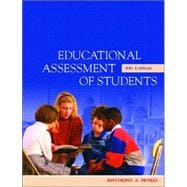
| The third edition contains: | |
| Balanced coverage of teacher-made tests (both paper and pencil and authentic assessments) and standardized assessments used in school settings | |
| Comprehensive coverage of all aspects of educational assessments, including basic measurement theory (i.e., reliability and validity), item construction, and using and interpreting standardized tests | |
| Teacher-focused instruction--all of the material in the text is presented in a classroom context | |
| Ancillaries to accompany the text include: | |
| An Instructor's Manual offering suggestions for teaching as well as numerous test items | |
| A Companion Website (http://www.prenhall.com/nitko) containing student self-assessments, web links, message board, live chat, and more | |
| Table of Contents provided by Publisher. All Rights Reserved. |
The New copy of this book will include any supplemental materials advertised. Please check the title of the book to determine if it should include any access cards, study guides, lab manuals, CDs, etc.
The Used, Rental and eBook copies of this book are not guaranteed to include any supplemental materials. Typically, only the book itself is included. This is true even if the title states it includes any access cards, study guides, lab manuals, CDs, etc.